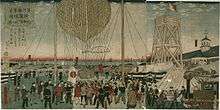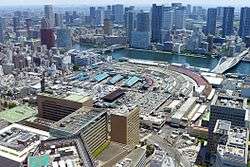Tsukiji
Tsukiji (築地) is a district of Chūō, Tokyo, Japan, the site of the Tsukiji fish market. Literally meaning "reclaimed land," it lies near the Sumida River on land reclaimed from Tokyo Bay in the 18th century, during the Edo period.
There are also districts named Tsukiji in Kobe and Amagasaki, cities in Hyōgo Prefecture, although neither is as well known as Tokyo's.
History
Tsukiji is built on reclaimed land out of what were once lowland marshes along the Sumida River delta. Throughout the Tokugawa period, earth from the shogunate's extensive moat and canal excavations was systematically used to fill in the marshes along the river, creating new commercial districts and waterfront housing.
The Great Fire of Meireki of 1657 destroyed over two-thirds of Edo's buildings, including Hongan-ji temple in Asakusa, the enormous Kantō headquarters of the Jōdo Shinshū sect.[1] As a result, the temple site was relocated to Tsukiji, where many of the residents of nearby Tsukudajima were instrumental in its reconstruction. A number of other temples were also erected on what is now the outer marketplace. In addition, many private residences for samurai and feudal lords were constructed along the southern edge of Tsukiji.
In 1869, Tsukiji was designated as an approved residential area for foreigners. As the Yokohama foreign settlement, opened in 1859, had already become a center for commercial activities and international trade, Tsukiji grew more as a focus for education, healthcare and Christian mission work. Early classroom and study facilities for Keio University, Rikkyo University, St. Margaret's Junior College, the American School in Japan and St. Luke's International Hospital were all to be found in this district.
From 1875 to 1890 the United States legation also occupied a site in Tsukiji now occupied by the St. Luke's Garden complex.

Tsukiji was also the location from 1869 of the Imperial Japanese Navy technical training facilities, renamed in 1876 as the Imperial Japanese Naval Academy. In 1888 the Naval Academy was relocated to from Tsukiji to new, larger facilities at Etajima in Hiroshima Prefecture. The Tsukiji naval buildings next to the Akibashi bridge then became home, until 1923, of the Naval War College, a post-graduate staff college for senior naval officers.
The Great Kantō earthquake on September 1, 1923, and the resultant fires which raged in its aftermath, caused severe damage throughout central Tokyo. A significant portion of the Tsukiji district burned to the ground, and the old Nihonbashi fish market was razed. In the citywide restructuring following the quake, the Nihonbashi fish market was relocated to the Tsukiji district, and after the construction of a modern market facility, reopened in 1935.
Places of interest
- For many residents and visitors to Tokyo, the Central Wholesale Market, better known as the Tsukiji fish market is synonymous with sushi, sashimi and seafood products of every kind. While the inner market in the early hours of the day has restricted access and is very much a working facility catering to wholesalers, the many small neighbourhood restaurants, restaurant supply stores and retail operations in the outer market still act as a major culinary tourist destination. Tsukiji is the largest fish market in the world handling more than 2000 tons of 450 types of seafood daily.[2]
- Tsukiji Hongan-ji, a key temple of the Jōdo Shinshū sect of Buddhism. Inside the temple is a small memorial to deceased popular rock star hide.
- The Sumida River, the Tsukiji riverbank has pedestrian access north of the Kachidoki Bridge.
- Quieter backsteets of Tsukiji still feature some older properties and storefronts clad in copper tiles used in the early Showa Period as a means of weather-proofing and distinctive architectural decoration.[3]
- St. Luke's Garden, one of Tokyo's taller buildings containing, offices, a hotel, residential and long-term care accommodation. Part of the St. Luke's International Hospital campus.
Gallery
 Tsukiji Storefront with copper wall cladding
Tsukiji Storefront with copper wall cladding Tsukiji Storefront with copper wall and balcony cladding
Tsukiji Storefront with copper wall and balcony cladding Tsukiji back street
Tsukiji back street
Companies based in Tsukiji
Foreign companies with offices:
Subway stations
- Tsukijishijō Station on Toei Ōedo Line
- Tsukiji Station on Tokyo Metro Hibiya Line
- Shintomicho Station on Tokyo Metro Yurakucho Line
- Walking distance from Shinbashi and Ginza
Education
Rikkyo Junior High School was established in Tsujiki in 1896 but the building was destroyed by the Great Kanto earthquake, so a new building in Ikebukuro opened in 1923.[8]
References
- ↑ "The Genesis of Tsukiji", Tsukiji Sushi Workshop. Retrieved on 29 October 2014.
- ↑ Billie Cohen (January 2005). "Lox, Stock, and Barrel". National Geographic Magazine.
- ↑ Bestor, Theodore C. (2004). Tsukiji: The Fish Market at the Center of the World. Berkeley: University of California Press. p. 62. ISBN 0-520-22024-2.
- ↑ "会社概要." Asahi Shimbun. Retrieved on February 26, 2010.
- ↑ "Relation." Asatsu DK. Retrieved on November 9, 2009.
- ↑ "会社概要." Nihon Ad Systems. Retrieved on February 26, 2010.
- ↑ "Sales Offices Europe and Other Countries." Avianca. Retrieved on January 10, 2017. "602 City Square, Tsukiji 6-4-5 Chuo-Ku 104-0045, Tokio."
- ↑ "History." Rikkyo Ikebukuro Junior and Senior High School. Retrieved on April 18, 2016. "立教池袋中学校・高等学校 〒171-0021 東京都豊島区西池袋5-16-5 "
External links
| Wikimedia Commons has media related to Tsukiji. |
Coordinates: 35°40′05″N 139°46′26″E / 35.66819°N 139.77390°E
